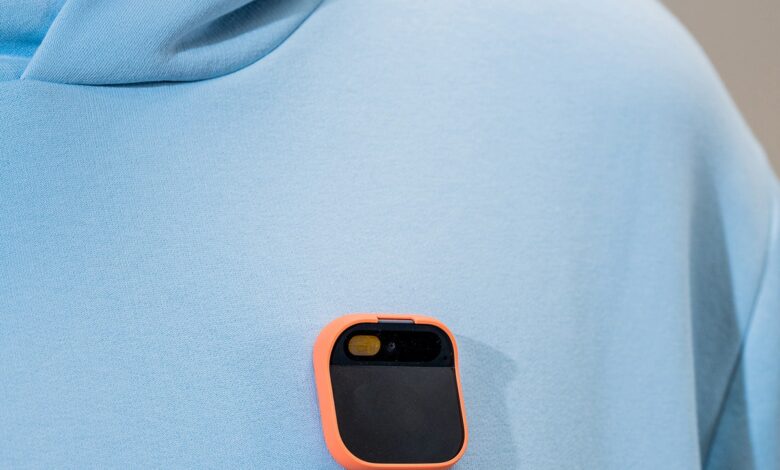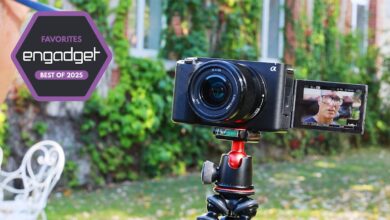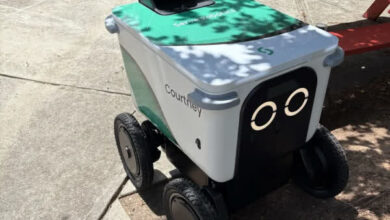Generative AI Doesn’t Make Hardware Less Hard

Things aren’t going so well for AI hardware startups.
After years of development, startup Humane launched a $700 wearable in early April that leans heavily on artificial intelligence. The original pitch for the Ai Pin was that you no longer need to juggle different apps; its operating system can “search for the right AI at the right moment,” allowing it to play music, translate languages, and even tell you how much protein is in a palmful of almonds. And because it doesn’t have a traditional display, the Ai pin was supposed to be a tiny tincture for the disease of screentime; smartphones were on their way out.
The pin has been panned. WIRED’s Julian Chokkattu scored the Ai Pin a 4 out of 10. Popular YouTuber Marques Brownlee complimented the device’s hardware design but still called it “The Worst Product I’ve Ever Reviewed … For Now.” The company has since massaged the message that it’s meant to replace your phone. Humane co-founder and chief executive Bethany Bongiorno has been fastidiously responding to displeased customers—and some fanboys—on Twitter, with apologies, assurances that improvements are coming, and video demos of the gadget’s UI, which replaces the smartphone in your palm by projecting lasers onto your palm.
Humane appears to have lost the thread on its own product launch, and it’s not alone. The cheaper Rabbit R1, which was sold for $200 as a generative AI “pocket companion” and generated a lot of initial excitement, has now been labeled “underwhelming,” “half-baked,” “undercooked” and “unreliable.” WIRED’s Chokkattu gave it a 3 out of 10, while some people have questioned the way the device handles logins for outside apps such as Uber.
These early hardware #fails aren’t unprecedented. Plenty of startups have overpromised in marketing and then built and shipped lackluster products. Competing in hardware is especially difficult in the age of Tech Giants, whose ecosystems rule over all. Developer Ben Sandofsky surmised that the Humane cofounders’ adherence to the “Apple Way,” or toiling in a secretive vacuum, is partly to blame. They spent years polishing that singular product the way a giant tech company would, he wrote in a blog post, but with $230 million in venture capital funding instead of billions in cash stores.
But both Humane and Rabbit appear to have made another error in judgment: Both were banking on AI excitement in the ChatGPT era to capture early customers and keep themselves out of the gadget graveyard. Instead, they rode the AI hype train straight into a non-working brick wall. It turns out generative AI doesn’t make hardware any less hard.
Expensive Flops
“To really create a great new AI device you have to have both hardware and software figured out, and the question with some of these startups is how much of that software layer is just a skin,” says MG Siegler, a partner at GV, Alphabet’s venture capital firm.
Sielger says that tech incumbents now have an even bigger advantage, because they can build using their own infrastructure and afford to lose money while they’re iterating on new versions of products. While startups are attempting to launch their scrappy AI products out of nothing, Meta, Google, Microsoft, and Apple can tap existing teams and services to put AI assistants into infinitely wearable sunglasses, churn out phones with built-in generative AI search, create designated keys for AI on their laptops, and pack their tablets with “outrageously powerful” AI chips.
“Bigger tech companies are able to have five shots on a hardware product whereas a startup may only have one,” says Jacob Andreou, an investor at Greylock who spent several years growing products at Snap. “The odds of one of these smaller companies raising a future fundraising round after releasing an expensive flop are not good odds.”
Bethany Bongiorno, Humane’s CEO and cofounder, acknowledged in a statement that “it is always a big challenge to create a first gen product” and said the company had issued “stability updates” to improve its device. “Ai Pin and its Ai OS, Cosmos, are about beginning the story of ambient computing and there is a long way to go in the category,” Bongiorno said. In a statement provided by Rabbit, founder and CEO Jesse Lyu said that the company is trying to “quickly and constantly improve the product while listening to the feedback from our highly active community.” Rabbit has released three software updates since the first R1 users received their devices, he said.
Humane and Rabbit aren’t the only startups jamming new variants of AI into new hardware. Limitless AI, previously called Rewind, recently revealed a clip-on pendant described as “a memory assistant that transcribes audio recordings.” A pair of intelligent ear discs from Iyo, spun out of Alphabet’s moonshot lab X, is supposed to be a “therapist, coach and tutor, all controlled through voice” when it launches late this year. And an AI compass called Terra uses APIs from Google and ChatGPT to guide users as they’re walking and hiking. Its design will be open source, to encourage people to build their own versions of the device.
Most of these startups are wielding AI to offer some kind of screen-free user interaction and conveying information without forcing users to open up a million mobile apps. Some are also betting that free, open-source AI models will become more powerful, easy to customize, and run on-device, or that AI cloud services will get faster and cheaper to license as the tech advances.
But even an AI hardware startup that develops a problem-solving and actually working product still has to compete with big companies that largely dictate consumers’ relationship with tech—while also convincing users to embrace new modes of interaction.
Jason Rugolo, the creator of the new AI gadget Iyo One, noted in a recent interview how much power Google and Apple still hold with their mobile platforms. “They’re built around their own graphical user interfaces, so those interactions take priority for them,” Rugolo tells WIRED. “We have an entirely new application model where conversation is the primary interaction, so we need to do things differently.”
Rugolo also says the language in marketing these new products changes a lot these days and that the emphasis on “GenAI” could be something of a fad. “We use a lot of tech. At the core of natural language interaction are large language models, which I would consider ‘GenAI,’” he says. “If it’s a hearing enhancement app, it’s more likely to use ‘machine learning,’ whereas a translation app these days is likely to use a large language model.”
Repeating Cycle
Christina Warren, a senior developer advocate at Microsoft’s GitHub who was previously a technology journalist, says the AI gadget scramble is reminiscent of the 2010’s era of consumer wearables and Kickstarter-funded gadgets. That was also spurred by newly available technology that made it easier to build.
“There was Google Glass, Pebble Watch, Oculus Rift, the Ouya video game console. There was some Instagram photo frame that I bought,” Warren says. “The Kickstarter gadgets in general kind of became a meme. You knew most were going to flop.”
A lot of gadgets at the time were built on top of Android, using forked versions of the Android Open Source Project and creating their own launchers or UIs for the products—not dissimilar to how gadget startups today are using APIs for services like ChatGPT and building their own software on top. “Android was probably one of the big drivers technologically of that era of devices, and then Kickstarter became the economic engine for bootstrapping them,” Warren says.
Most of the novel gadgets that survived the 2010s were developed or absorbed by giant tech companies. Pebble executed well on its open-source smartwatch vision, Warren says, but its tech ended up at Google by way of a Fitbit acquisition, a kind of wearable tech turducken. VR headset maker Oculus was acquired early to seed Facebook’s VR plans. Amazon essentially created the smart speaker category with Alexa, and Apple’s high-gloss take on a smartwatch won. Along the way, all three of those big companies reached trillion dollar market caps and got deeper into hardware development, even crafting their own computer chips. For upstarts like Humane and Rabbit, invoking the magic of calling a product “GenAI” is hardly enough to surmount this.
Siegler says that in order for any AI hardware startup to be successful right now, it needs to think about its brand reputation and, most importantly, “keep it super simple.”
“If you come out saying you’re going to create a better world, it’s way too grandiose,” he says. “And smartphones can do a lot of this stuff already. So you need to start out doing something as simple as possible, like a wearable that only invokes one AI model and has an element of purpose.”
Some aspects of building an AI wearable could get easier. Andreou believes that some AI hardware startups are likely to turn to original device manufacturers, obscure companies that make products for consumer brands to put their own stamps on or enhance with software, in order to offload some of the costs of manufacturing the product.
“You need to have one or two people in the organization managing hardware and outsource most of the rest to keep costs small,” he says. Hardware startups will also increasingly turn to a subscription model to boost revenue, he predicts. Some have already tried to do that—Humane charges $24 a month—but the product itself has to, you know, work.
Warren thinks that smaller, open-sourced AI models that can run directly on devices and require less computational power might also be an opportunity for fledgling companies with limited capital to inject AI into their products. “But the question is still then, what kind of hardware are you building?” she says. Right now some of the hardware makers themselves don’t seem to know the answer.


